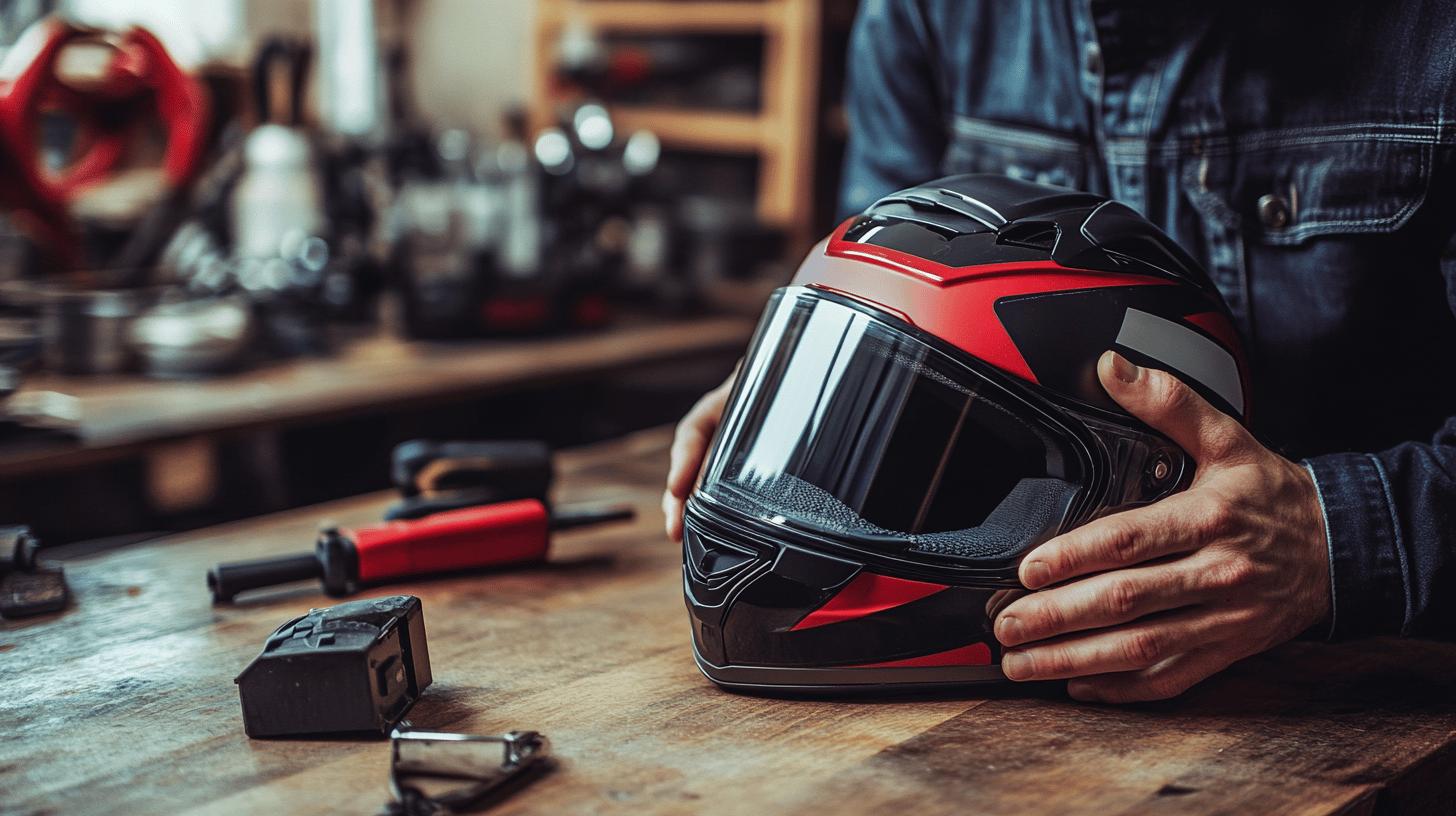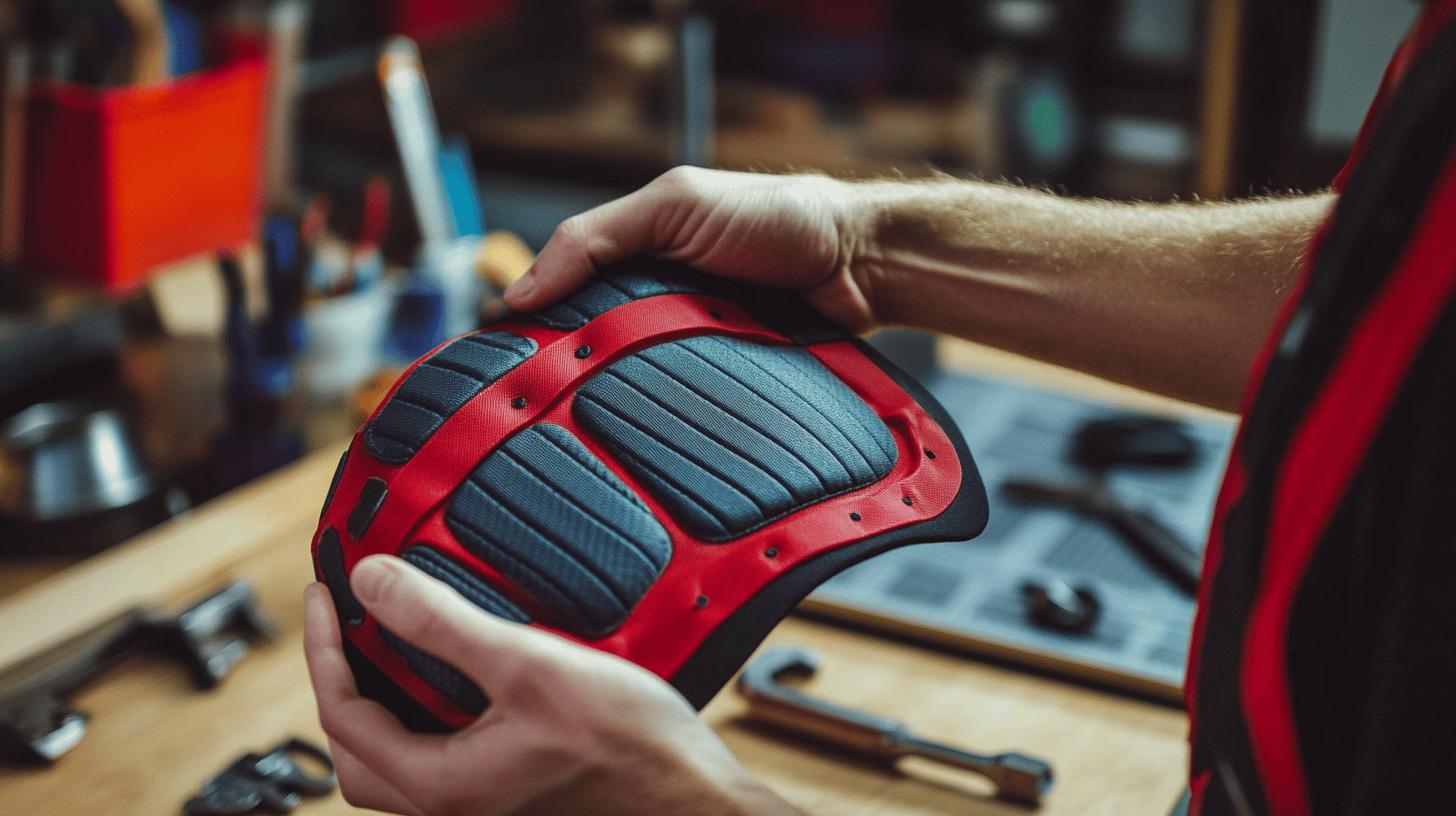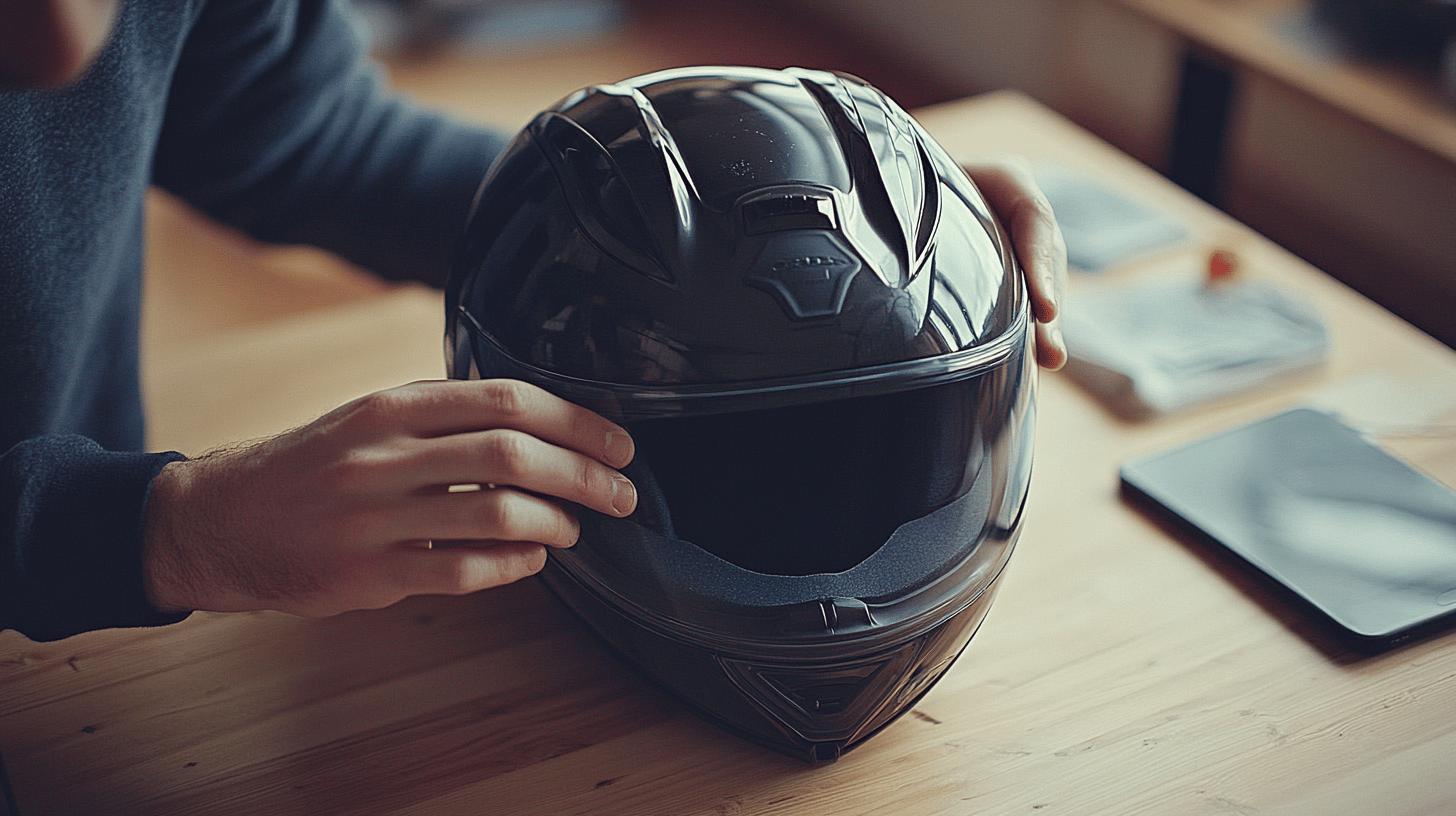Have you ever wondered if your motorcycle helmet is supposed to feel tight enough to leave marks on your forehead after a ride? Finding the perfect motorcycle helmet fit can be a tricky balancing act between comfort and safety.
Proper helmet snug fit is essential, allowing for protective helmet function during rides without compromising comfort. In this article, learn how to stretch a motorcycle helmet comfortably, explore helmet fit guidelines, and discover techniques to create a personalized fit that doesn't sacrifice safety.
Let's ensure you're ready for the road with confidence and protection.
Understanding the Importance of Proper Helmet Fit

A snug motorcycle helmet fit is paramount for rider safety, as it ensures the helmet remains securely in place during a crash. A properly fitting helmet should feel slightly tight, providing even pressure around the head without causing discomfort.
This tightness is critical in minimizing movement upon impact, thereby reducing the risk of head injuries. Helmets certified by safety standards like DOT or ECE are designed to perform optimally when fitted correctly, which underscores the importance of adhering to helmet fit guidelines.
An improperly fitting helmet can lead to significant discomfort and increased safety risks. A helmet that's too loose may shift during a ride, affecting the rider's concentration and vision.
Conversely, a helmet that's too tight can cause headaches, pressure points, and restricted blood flow, leading to fatigue. Both scenarios can compromise the helmet's protective capabilities, highlighting the necessity of ensuring a helmet snug fit to maintain safety and comfort.
Different helmet types—such as full-face, open-face, and modular helmets—offer varying levels of protection and fit characteristics. Full-face helmets provide comprehensive coverage and protection, making them ideal for high-speed riding.
Open-face helmets offer more visibility and ventilation but less facial protection. Modular helmets combine features of both, offering versatility. Each type requires specific fitting considerations to ensure optimal safety and comfort, emphasizing the need to choose a helmet that matches both riding style and head shape.
Techniques to Stretch Your Motorcycle Helmet Safely

Stretching a motorcycle helmet to improve fit involves careful adjustments to the foam liner, not the hard outer shell. The foam liner is designed to absorb impact, and altering it can help achieve a more comfortable fit without compromising safety.
When considering how to stretch a motorcycle helmet, it's important to focus on methods such as modifying the padding or reshaping the foam. These techniques allow for slight adjustments in fit, accommodating head shape changes or break-in needs.
However, there are risks associated with altering helmet padding, as improper adjustments can compromise structural integrity. Always prioritize helmet integrity over comfort to maintain protection levels.
Stretching helmet padding should be done cautiously, ensuring that no changes affect the helmet's safety standards. It's advisable to make minimal adjustments, as excessive modifications can reduce the helmet's ability to protect in an accident.
-
Identify Pressure Points: Wear the helmet for short periods to pinpoint areas causing discomfort or pressure.
-
Use Heat: Gently warm the foam liner with a hairdryer on low heat to make it more pliable. Avoid overheating, which can damage the foam.
-
Apply Pressure: Use your hands to apply pressure to the warmed areas needing expansion, carefully stretching the foam.
-
Replace Pads: Consider swapping out the current pads for thinner ones, available in helmet padding kits, to create more space.
-
Wear and Test: After adjustments, wear the helmet to test comfort and fit. Repeat the process if necessary, ensuring the helmet aligns with safety standards.
By following these steps, riders can achieve a comfortable fit while maintaining the protective qualities of their helmet.
Tools and Materials Needed for Helmet Adjustments

Utilizing the correct tools and materials for helmet padding adjustment is crucial for ensuring that modifications do not compromise the helmet's safety features. Proper equipment helps achieve a comfortable fit while maintaining the helmet's protective integrity.
Helmet padding kits and custom foam inserts are particularly useful, allowing for precise adjustments that cater to individual head shapes and sizes. These tools enable riders to make small, safe changes, enhancing comfort without affecting the helmet's structural resilience.
- Helmet padding kit
- Custom foam inserts
- Hairdryer (for gentle heating)
- Measuring tape
- Replacement pads of varying thickness
- Adhesive strips or Velcro
- Foam contouring tool
Employing these tools and materials offers significant benefits. They empower riders to tailor their helmets to fit snugly, reducing pressure points and potential discomfort. Custom foam inserts allow for targeted adjustments, while replacement pads provide flexibility in achieving the desired fit.
Using these resources responsibly ensures that the helmet continues to meet safety standards, providing optimal protection and comfort during rides.
Recognizing When Your Helmet Needs Professional Adjustment

When should a helmet be adjusted professionally? If adjustments using available tools and materials do not alleviate discomfort or tightness, professional help may be necessary. Helmets that consistently cause pressure points, headaches, or impede vision despite attempts to fix helmet tightness suggest an underlying fit issue that simple padding changes cannot resolve.
Additionally, if the helmet shifts excessively or feels insecure, these are clear signs that the fit needs professional attention. A thorough helmet fit troubleshooting process by an expert can identify these persistent issues and provide solutions tailored to the rider's specific needs.
Attempting DIY adjustments can pose risks. What are the dangers of DIY helmet modifications? Incorrect alterations can compromise helmet integrity and fit, reducing its ability to protect during an accident. The helmet's shell and liner are designed to work together to absorb impact energy, and any unprofessional changes might disrupt this crucial balance.
Professional services ensure any modifications preserve the helmet's structural integrity and compliance with safety standards. By consulting a specialist, riders can avoid the pitfalls of DIY methods, ensuring their helmet offers the best possible protection and comfort. Seeking expert advice can also extend the helmet's lifespan, safeguarding both the rider's investment and safety.
Tips for Maintaining Helmet Shape and Comfort Over Time

Regular maintenance of a motorcycle helmet is crucial for preserving both its shape and comfort. Consistent care not only extends the helmet's lifespan but also ensures that it continues to offer maximum protection. Inspection for wear or damage is a necessary routine, as even minor cracks or compromised padding can reduce a helmet's effectiveness in a crash.
Helmets adhere to safety standards that rely heavily on their structural integrity, which can degrade over time without proper maintenance. By paying attention to these details, riders can maintain helmet fit and comfort, ensuring a snug and secure ride.
-
Clean Regularly: Use mild soap and water to clean the helmet shell and interior, removing sweat and grime that can degrade materials.
-
Inspect for Damage: Regularly check for cracks, loose padding, or other signs of wear that could compromise safety.
-
Adjust Padding: Use helmet interior modifications, such as adjusting or replacing worn pads, to maintain a comfortable fit.
-
Store Properly: Keep the helmet in a cool, dry place away from direct sunlight to prevent material degradation.
-
Check Visor and Straps: Ensure visors are scratch-free and straps are secure and functional.
The break-in period of a helmet is a natural process during which the padding conforms to the rider's head shape. This period can significantly enhance comfort, as the helmet becomes more tailored to individual needs.
Initially, a new helmet may feel tight, but as it breaks in, the fit will adjust slightly. Understanding this process helps riders avoid premature discomfort and allows them to anticipate the eventual comfort that comes with a properly broken-in helmet. Regular checks and adjustments during this period ensure that the helmet remains both comfortable and protective.
When It's Time to Replace Your Helmet

A helmet needs replacing when it no longer fits properly, as a poor fit compromises safety. How can you tell if a helmet requires replacement? Look for signs such as excessive movement during rides, discomfort despite attempts to fix the fit, or visible wear and tears like cracks or degraded padding.
These indicators suggest the helmet's protective capabilities are diminished. Additionally, a helmet that feels loose or allows more than one finger between the forehead and the interior signifies it's time for a replacement. Regular wear can cause the padding to compress, altering the helmet's snug fit, necessitating a reassessment of its effectiveness.
To assess and choose the correct size for a new helmet, start by measuring your head circumference using a flexible measuring tape. Compare this measurement to the helmet size guide provided by manufacturers, as sizing can vary across brands and models. When selecting a helmet, consider your head shape—long oval, intermediate oval, or round oval—to ensure optimal comfort and protection.
Try on several models to evaluate their fit, ensuring they feel snug without causing pressure points. A proper helmet fit assessment includes conducting a roll-off test; the helmet should stay secure when you try to roll it off your head. This ensures the new helmet provides the required level of safety and comfort.
Final Words
Proper motorcycle helmet fit ensures crucial safety and comfort for riders. Techniques to stretch a helmet safely can improve fit, but knowing when adjustments require professional intervention is vital. Equipped with the right tools, riders can maintain their helmet’s comfort over time. Replacing worn or ill-fitting helmets with properly sized options remains essential for optimal protection. Understanding how to stretch a motorcycle helmet can significantly enhance the riding experience. Embrace these practices for a safer ride.
FAQ
How do you stretch a tight motorcycle helmet?
A tight motorcycle helmet can be stretched by adjusting its foam liner. Gradually, wear the helmet for short periods to allow the interior padding to mold to your head. Alternatively, use a helmet stretcher device for adjustment.
How to break in a tight motorcycle helmet?
To break in a tight motorcycle helmet, wear it for about 20–30 minutes daily. This helps the padding conform to your head shape, providing a more comfortable fit over time.
Will my motorcycle helmet loosen up?
A motorcycle helmet may loosen slightly during the break-in period. As you wear it, the interior padding compresses and molds to your head, enhancing overall fit and comfort.
Can you resize a motorcycle helmet?
Resizing a motorcycle helmet is limited to internal adjustments. Replacing or adding padding can help, but altering the helmet's outer shell is not recommended due to safety risks.
What to do if your motorcycle helmet is tight on the forehead?
If a helmet is tight on the forehead, consider swapping or adjusting the interior padding. A thin layer of cloth can also be added to alleviate pressure without compromising safety.
How to adjust a motorcycle helmet that's tight on cheeks?
Adjusting a helmet tight on the cheeks involves replacing cheek pads with thinner options. Some helmets offer interchangeable pads for customizable fit, enhancing comfort without altering safety.
What are the risks of helmet pressure points?
Helmet pressure points can cause discomfort and distract riders. Prolonged pressure may also lead to headaches or skin irritation, emphasizing the need for a fit that balances snugness and comfort.
How to use motorcycle helmet extra padding?
Motorcycle helmet extra padding can fine-tune a helmet's fit. Insert pads strategically to fill loose areas, ensuring even pressure distribution and enhancing comfort.
Do motorcycle helmets stretch over time?
Motorcycle helmets may stretch slightly as padding conforms to your head shape. Consistent use aids this process, promoting a comfortable fit without compromising safety features.
What is a helmet stretcher?
A helmet stretcher is a tool that expands a helmet's interior to relieve tightness. It provides gradual stretching and is especially helpful for minor fit adjustments without damage.

Brad Mitchell is a seasoned motorcycle enthusiast with over 16 years of riding experience. He’s spent countless hours on the open road, particularly favoring scenic routes aboard his trusted Harley-Davidson. Brad’s laid-back approach to life and riding gives him a unique perspective on motorcycle gear and safety, which he shares through his in-depth reviews and expert advice on ProtectiveGearz.



